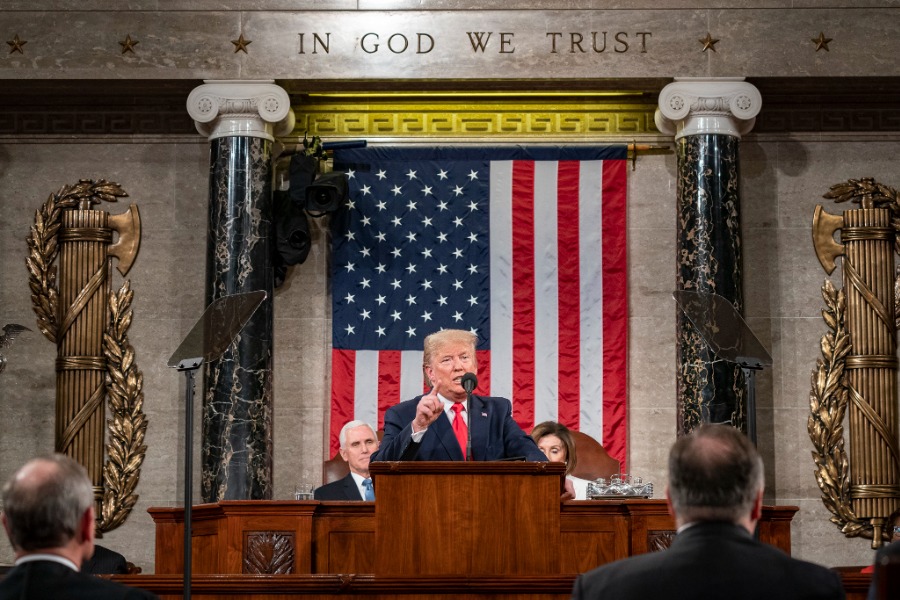Smith v. Trump In the D.C. Circuit: A Guided Tour of the Oral Argument
Together with David Remes, I presented Capt. Nathan Smith's challenge to the war against the Islamic State before the D.C. Circuit Court of Appeals on Oct. 27. Judge Thomas Griffith presided, with Judges David Sentelle and Raymond Randolph, joining in a wide-ranging discussion of doctrine and cases that touched on many national security law problems. While the court had officially granted 15 minutes to each side, the hearing lasted for more than an hour. The court has provided a recording of the argument.
Published by The Lawfare Institute
in Cooperation With

Together with David Remes, I presented Capt. Nathan Smith's challenge to the war against the Islamic State before the D.C. Circuit Court of Appeals on Oct. 27. Judge Thomas Griffith presided, with Judges David Sentelle and Raymond Randolph, joining in a wide-ranging discussion of doctrine and cases that touched on many national security law problems. While the court had officially granted 15 minutes to each side, the hearing lasted for more than an hour. The court has provided a recording of the argument.
Remes' argument began with questions of standing, which principally revolved around the D.C. Circuit's oath of office cases—most importantly, the relationship between Allen (granting standing) and Rodearmel (denying it). Next, Remes discussed special problems involved in suing the president, either for an injunction or a declaratory judgment. There was also a discussion of the point at which a declaratory judgment crosses the line and becomes a mere advisory opinion.
It was then my turn to advance the argument by taking up a different dimension of the standing issue—basing our theory of standing on the fact that the statutory oath required of enlisted personnel insists that they obey the commands of superiors, while the officer's oath exclusively demands fealty to the Constitution. The discussion of the point to an historical turn that developed Remes' earlier consideration of Little v. Barreme and the "Test Oaths" of the Civil War and Reconstruction period.
The next 15 minutes was dedicated to the political question doctrine. Discussion began with an assessment of the relationship between the D.C. Circuit's recent Ali Jabr v. United States decision to its early en banc decision in Eli Shifa v. United States. It then moved to confront the Steel Seizure case and its relationship to Baker v. Carr's different doctrinal definition of political question issues. This led to a discussion of the key legal questions involved in assessing President Barack Obama's claim that the 2001 and 2002 authorizations for the use of military force (AUMF) authorized his 2014 decision to initiate hostilites against the Islamic State. First, I discussed the letter submitted by national security adviser Susan Rice to the speaker of the House on July 25, 2014, advising the speaker that the 2002 AUMF had not served as the basis for American operations in Iraq since Dec. 2011. How, then, could Obama claim that the AUMF justified the initiation of hostilities against the Islamic State two months later? This question generated further discussion of El Shifa and the propriety of suing the president.
The next seven minutes returned to the competing political question doctrines advanced in Steel Seizure and Baker—and why the two decisions required very different assessments of Congress' ongoing decisions to fund the campaign against the Islamic State in a series of general appropriations acts. My presentation ended with further discussion of the propriety of naming the president, rather than his inferior officers, as the defendant in this lawsuit.
The government's presentation turned first to standing and argued that Rodearmel, not Allen, provided the governing precedent for this case. The government argued that the difference between the cases turned on whether the injury-in-fact is found in the constitutionality of the acts conducted by the plaintiffs or in the constitutionality of the acts of a third party. Thus, the government concluded that Capt. Smith does not claim a cognizable injury under Rodearmel. Upon prompting by Sentelle, the government also explored the significance of Little v. Barreme to its political question doctrine arguments. The government argued that the debate between the political branches concerning the AUMF is not for judicial resolution. Furthermore, the government argued that the relief requested would be closer to an advisory opinion and not a declaratory judgment. It concluded with a series of colloquies in which the government ultimately took the position that it is never proper for the judiciary to exercise judicial control over presidential war-making under the War Powers Resolution (WPR) and the president's interpretation of the AUMF. On this view, Baker v. Carr, not the Steel Seizure case, serves as the decisive precedent in all future cases arising under the WPR.
In the time reserved for rebuttal, Remes discussed the significance of the D.C. Circuit's 1996 Swann decision in defining the conditions under which the president might appropriately serve as a defendant in a lawsuit. I then countered the government's claim that all challenges under the WPR raised political questions and argued that the Steel Seizure case serves as the decisive precedent in the present case.
To do justice to the rich complexity of the discussion, on this and all the other issues, it will pay to listen to the give-and-take at the hearing.



.jpg?sfvrsn=6cdd11de_5)

